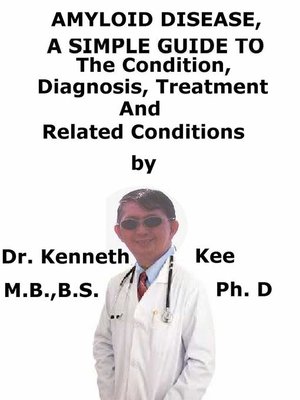Amyloid Disease, a Simple Guide to the Condition, Diagnosis, Treatment and Related Conditions
ebook
By Kenneth Kee

Sign up to save your library
With an OverDrive account, you can save your favorite libraries for at-a-glance information about availability. Find out more about OverDrive accounts.
Find this title in Libby, the library reading app by OverDrive.



Search for a digital library with this title
Title found at these libraries:
| Library Name | Distance |
|---|---|
| Loading... |
This book describes Amyloid Disease, Diagnosis and Treatment and Related Diseases
Amyloid Disease is a progressive disease affecting the tissue infiltrates of insoluble proteins or amyloid proteins leading to poor function of the organs involved.
Amyloid Disease is a medical disorder produced by extra-cellular and or intra-cellular deposition of insoluble abnormal amyloid fibrils that alter the normal function of tissues.
In humans there are about 23 different unrelated proteins known to form amyloid fibrils in vivo.
Proteins that develop into amyloid fibrils differ in size function, amino acid effect and native structure but become non-soluble clumps that are similar in structure and in properties.
In the past amyloid disease was classified as primary amyloid disease 70% or secondary amyloid disease but with chemical testing of the amyloid protein, Amyloid is categorized chemically.
The amyloid diseases are termed with a capital A (for amyloid) accompanied by an abbreviation for the fibril protein:
1.AA amyloid disease contains a normal-sequence serum amyloid A protein
The kidneys, joints, liver and spleen are the main targets of AA amyloid deposits
2.AL amyloid Disease was previously known as primary amyloid disease
Organs involved are the heart, kidney, peripheral nerve, gastrointestinal tract, respiratory tract and nearly any other organ.
AL amyloid disease is the most frequent type of systemic amyloid disease in developed countries
3.Transthyretin amyloid disease (ATTR) is the most frequent inherited systemic type of amyloid disease
ATTR is an autosomal-dominant disease but is linked with at least 100 different transthyretin (TTR) mutations
There are many other amyloid diseases.
Symptoms:
This disease can involve the tongue, intestines, skeletal and smooth muscles, nerves, skin, ligaments, heart, liver, spleen and kidneys
1.Fatigue,
2.Weight loss,
3.Easy bruising,
4.Breathlessness,
5.Peripheral edema,
6.Sensory change,
7.Carpal tunnel syndrome
8.Postural hypotension
Signs:
1.Unexplained renal disease
2.Massive proteinuria
3.Cardiac amyloid disease
4.Marked hepatomegaly with kidney disease:
5.Sensory glove- and stocking-type polyneuropathy:
a.Particularly carpal tunnel syndrome
6.Vitreous opacities
7.Gastrointestinal amyloid
8.Skin lesions:
a.Spontaneous periorbital purpura - racoon eye
9.A firm, symmetrical, non-tender goiter
Diagnosis:
Biopsy of an affected organ, or simple subcutaneous aspiration of abdominal fat - stains red with Congo red stain giving red-green birefringence under polarized light
Diagnosis is validated in 80% of cases
Immunofixation electrophoresis can confirm the type of amyloid disease
Treatment
No treatment is present that specifically targets the amyloid deposits,
The treatment is therefore directed at suppressing the underlying plasma cell dyscrasia along with supportive measures to support and possibly preserve organ function.
Supportive
1.Symptoms must be treated, e.g. diuretics for renal failure, erythropoietin for anemia.
2.Congestive heart failure may respond to diuretics, but larger doses are often required as the disease progresses.
Underlying Disorder
Any underlying causes, e.g. inflammatory disorders, chronic infection or carcinoma, should be treated
Specific treatment
Alkylator-based chemotreatment is effective to some degree in almost 66% of patients.
Trials with novel medicines such as thalidomide, lenalidomide, pomalidomide and bortezomib have shown promising results.
Stem...







